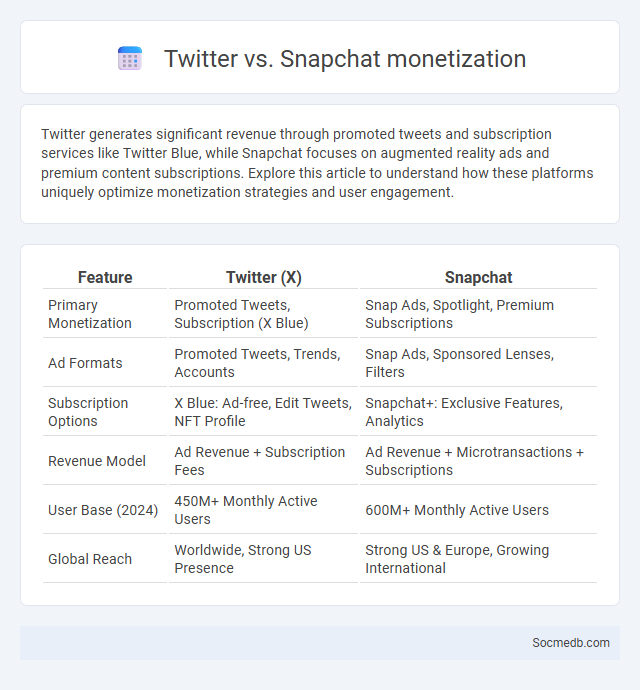
Photo illustration: Twitter vs Snapchat monetization
Twitter generates significant revenue through promoted tweets and subscription services like Twitter Blue, while Snapchat focuses on augmented reality ads and premium content subscriptions. Explore this article to understand how these platforms uniquely optimize monetization strategies and user engagement.
Table of Comparison
| Feature | Twitter (X) | Snapchat |
|---|---|---|
| Primary Monetization | Promoted Tweets, Subscription (X Blue) | Snap Ads, Spotlight, Premium Subscriptions |
| Ad Formats | Promoted Tweets, Trends, Accounts | Snap Ads, Sponsored Lenses, Filters |
| Subscription Options | X Blue: Ad-free, Edit Tweets, NFT Profile | Snapchat+: Exclusive Features, Analytics |
| Revenue Model | Ad Revenue + Subscription Fees | Ad Revenue + Microtransactions + Subscriptions |
| User Base (2024) | 450M+ Monthly Active Users | 600M+ Monthly Active Users |
| Global Reach | Worldwide, Strong US Presence | Strong US & Europe, Growing International |
Overview of Monetization on Twitter and Snapchat
Twitter monetizes through advertising, including promoted tweets, accounts, and trends, along with subscription services like Twitter Blue offering exclusive features. Snapchat generates revenue primarily from Snap Ads, sponsored lenses, and Discover content partnerships, integrating augmented reality for enhanced user engagement. Both platforms leverage targeted advertising algorithms and user data analytics to maximize ad revenue and provide personalized content experiences.
Key Differences in Platform Monetization Models
Social media platforms utilize distinct monetization models, with Facebook and Instagram primarily generating revenue through targeted advertising and sponsored content, while YouTube emphasizes ad revenue sharing with content creators via its Partner Program. TikTok combines in-app purchases, brand partnerships, and advertising to monetize engagement, contrasting with Twitter's blend of promoted tweets and subscription services like Twitter Blue. Understanding these differences can help you select the right platform to maximize your content's earning potential.
Creator Monetization Tools: Twitter vs Snapchat
Twitter offers robust creator monetization tools including Super Follows, Ticketed Spaces, and Tip Jar, enabling you to earn directly from your content and live interactions. Snapchat's Spotlight program rewards creators with cash bonuses based on the popularity of their short-form videos, plus features like subscriptions and exclusive content for fans. Both platforms provide unique monetization opportunities, but Twitter emphasizes ongoing engagement while Snapchat prioritizes viral video content.
Revenue Sharing Policies for Creators
Revenue sharing policies for creators on social media platforms directly impact content monetization and influencer earnings. Platforms like YouTube and TikTok offer varying percentages of ad revenue, sponsorship deals, and subscription fees to incentivize quality content production. Transparent revenue sharing models foster creator loyalty and drive platform growth by aligning financial incentives with content engagement metrics.
Advertising Opportunities and Formats
Social media platforms offer diverse advertising opportunities and formats designed to maximize audience engagement and conversion rates. You can leverage options like sponsored posts, video ads, carousel ads, and influencer partnerships to tailor your marketing strategy effectively. These formats enable targeted campaigns by utilizing data-driven insights such as user demographics, interests, and behavior patterns to optimize ad performance.
Partner Programs and Eligibility Criteria
Partner programs on social media platforms offer exclusive benefits tailored to content creators and businesses, including monetization opportunities and advanced analytics tools. Eligibility criteria typically require a minimum follower count, consistent engagement metrics, and adherence to community guidelines to ensure quality and compliance. To maximize your chances of acceptance, focus on growing your audience organically and maintaining high-quality content that aligns with platform standards.
Audience Engagement and Growth Potential
Maximizing audience engagement on social media involves leveraging interactive content such as polls, live videos, and user-generated posts, which significantly boost follower interaction rates. Platforms like Instagram and TikTok demonstrate the highest growth potential due to their algorithmic emphasis on personalized content discovery, attracting diverse demographics. Consistent analytics tracking and targeted advertising strategies empower brands to refine their messaging and expand their social media footprint efficiently.
Payout Methods and Minimum Thresholds
Social media platforms offer various payout methods including direct bank transfers, PayPal, and digital wallets to ensure convenient earnings withdrawal. Minimum thresholds for payouts vary, typically ranging from $10 to $100, depending on the platform's policies and your chosen payout method. Understanding your platform's payout schedules and minimum requirements is essential to efficiently manage and maximize your social media revenue.
Case Studies: Successful Creators on Each Platform
TikTok creator Charli D'Amelio transformed dance videos into a global brand with over 150 million followers. On YouTube, MrBeast leverages viral challenges and philanthropy, amassing more than 140 million subscribers. Your social media strategy can benefit from analyzing these creators' content consistency, audience engagement, and platform-specific trends.
Future Trends in Social Media Creator Monetization
Future trends in social media creator monetization emphasize diversified revenue streams such as direct fan subscriptions, exclusive content, and branded partnerships facilitated by AI-driven analytics. Platforms increasingly adopt blockchain technology for transparent royalty payments and NFT-based digital assets, enhancing creator earnings. Your ability to leverage emerging tools like live shopping integrations and virtual events will be crucial for maximizing income and audience engagement in the evolving social media landscape.
 socmedb.com
socmedb.com